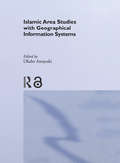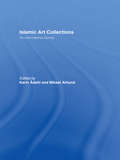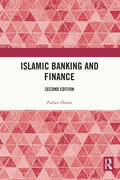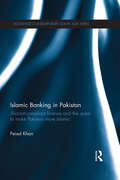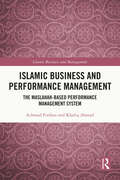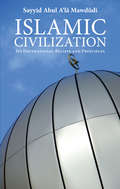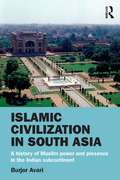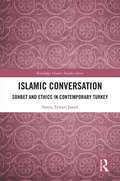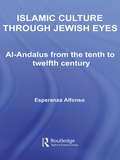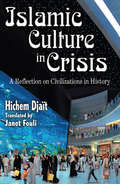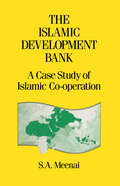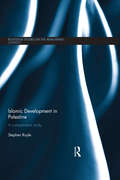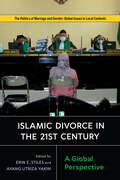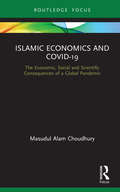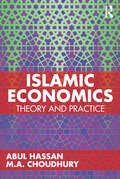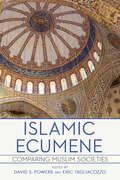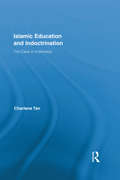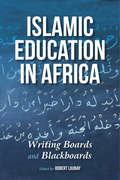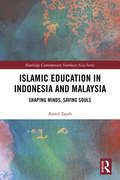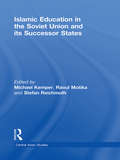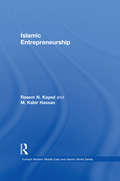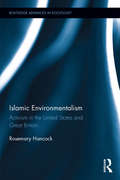- Table View
- List View
Islamdebatten im Deutschen Bundestag 1990–2009: Eine Habitusanalyse zur Formierungsphase deutscher Islampolitik (Politik und Religion)
by Sebastian Matthias SchlerkaSowohl anhand einer Vollerfassung aller Bundestags-Drucksachen und Plenarprotokolle aus den Jahren 1990-2009, in denen von Islam oder Muslim*innen die Rede ist, als auch anhand einer Habitusanalyse von vier ausgewählten Debatten – zum „Asylkompromiss“ 1993, zu einer außenpolitischen Islamkonferenz 1995, zur Streichung des Religionsprivilegs 2001 und zur Einsetzung der Deutschen Islamkonferenz 2006 – wird in diesem Buch herausgearbeitet, wie die Kategorien „Islam“ und „Muslim*innen“ von den Abgeordneten konstruiert werden. Dabei zeigt sich unter anderem, dass Muslim*innen durchgehend als Eingewanderte betrachtet werden, während der Islam mit potenzieller Bedrohung assoziiert wird.
Islamic Area Studies with Geographical Information Systems (New Horizons in Islamic Studies)
by Okabe AtsuyukiIn this volume the contributors use Geographical Information Systems (GIS) to reassess both historic and contemporary Asian countries and traditionally Islamic areas. This highly illustrated and comprehensive work highlights how GIS can be applied to the social sciences. With its description of how to process, construct and manage geographical data the book is ideal for the non-specialist looking for a new and refreshing way to approach Islamic area studies.
Islamic Art Collections: An International Survey
by Karin AdahlAn annotated index and general orientation of Islamic art collections in museums, libraries, other institutions and on private hands. Includes a short description of each collection, its main characteristics, documentation, publications and exhibitions.
Islamic Art and Archaeology in Palestine
by Myriam Rosen-AyalonDespite political upheavals under Muslim domination in the Middle Ages, Palestine was a center of great artistic activity recognized for its incredible dynamism. Its unique contribution to the Islamic “macrocosm,” however, never became the subject of extensive study. Numerous archeological excavations on this relatively small geographic area reveal the existence of extremely well preserved monuments of high architectural quality and exceptional religious value. This is what Myriam Rosen-Ayalon exposes in this thorough introduction to Palestinian Islamic art and archeology. In chronological order she presents here for the first time the multifaceted and long-lasting achievements of Islamic art in Palestine, filling the gap of years of neglect on the subject.
Islamic Banking and Finance: Second edition
by Hasan ZubairThis book discusses the nature and theories which govern systems of Islamic finance including its most distinctive features and its relationship with conventional financial institutions. It explores the nature and role of money in modern economies and elaborates on the process of credit deposit creation, trade cycles and instruments for the creation of value in financial markets through the perspectives of Islamic finance. The author explains its characteristics, especially the rationale for the lack of interest-based financial activities. He examines the intrinsic ethical and humanistic frameworks that govern financial theories and practices and the models for the creation of value, risk-sharing and socially responsible investing, as well as the governance and regulation that these systems follow. The author also does a comparative assessment of conventional financial systems with Islamic finance with relevant examples, assesses the performance of Islamic systems and examines existing and expanding markets for Islamic finance. Lucid and cogent, this book is useful for scholars and researchers of Islamic finance, Islamic studies, economics, banking and finance in general.
Islamic Banking in Pakistan: Shariah-Compliant Finance and the Quest to make Pakistan more Islamic (Routledge Contemporary South Asia Series)
by Feisal KhanIslamic Banking and Finance (IBF) has become a growing force over the past three decades, with Pakistan being one of the IBF pioneers by converting to an ‘interest-free’ banking system in 1985. However, since independence in 1947, there has been continual tension over Pakistan’s essential character, between Islamic Minimalists, who favour a Modernist interpretation of Islam, and those who favour an Islamic Maximalist interpretation that sees Pakistan as a model Islamic state. This book analyses the push to Islamize Pakistan and its financial system by Islamic revivalists, following the early 1947 debates in the original Constituent Assembly to the final 2002 ruling on IBF of the Shariat Appellate Bench of the Pakistan Supreme Court. It examines the practice and theory behind contemporary Islamic, "Shariah-compliant", banking. It offers extensive interviews with Pakistani Islamic bankers on the state of their industry and how they see it developing, and provides analysis on how the Islamic banks’ customers differ from those of conventional ones. Presenting a critical analysis of Pakistan’s IBF experience and offering a new insight into Pakistan’s banking industry that illustrates broader political and social trends in the country, this book will be of interest to specialists on Islam, South Asia and International Economics.
Islamic Business and Performance Management: The Maslahah-Based Performance Management System (Islamic Business and Management)
by Khaliq Ahmad Achmad FirdausThis unique book discovers a new dimension in the study of strategic and performance management in Islamic Business studies. It addresses the missing link of spirituality from modern-day organizational structure in the presence of high-tech pressure in all areas of human endeavours. The authors propose an integrated study of Islamic business approach to strategic and performance management systems to achieve sustainable organizational performance. The book explores employees’ wellbeing and organizations’ perceiving work environment as a spiritual pathway to cultivate values in Islamic business ecosystem to sustain humanity. It is all about care, empathy, and sustenance of others, about truthfulness and management being truthful to themselves and others and endeavouring to live their values more effusively while performing their work. The book stresses the impact of spirituality in performance management, concluding that for any organization to run efficiently, spirituality is the core component to attain happiness, contentment, and success. The book will be of interest to a variety of management scholars, including those researching and studying performance management, talent management, strategic management, and business ethics.
Islamic Civilization
by Sayyid Abul Mawdudi Syed AkifMawdudi argues that the true understanding of Islamic civilization is possible only by having access to the soul of that civilization and its underlying fundamental principles - belief in God, the angels, the Prophets, the Revealed Books and the Last Day - rather than to its manifestations in knowledge, literature, fine arts, social life or its system of governance.
Islamic Civilization in South Asia: A History of Muslim Power and Presence in the Indian Subcontinent
by Burjor AvariMuslims have been present in South Asia for 14 centuries. Nearly 40% of the people of this vast land mass follow the religion of Islam, and Muslim contribution to the cultural heritage of the sub-continent has been extensive. This textbook provides both undergraduate and postgraduate students, as well as the general reader, with a comprehensive account of the history of Islam in India, encompassing political, socio-economic, cultural and intellectual aspects. Using a chronological framework, the book discusses the main events in each period between c. 600 CE and the present day, along with the key social and cultural themes. It discusses a range of topics, including: How power was secured, and how was it exercised The crisis of confidence caused by the arrival of the West in the sub-continent How the Indo-Islamic synthesis in various facets of life and culture came about Excerpts at the end of each chapter allow for further discussion, and detailed maps alongside the text help visualise the changes through each time period. Introducing the reader to the issues concerning the Islamic past of South Asia, the book is a useful text for students and scholars of South Asian History and Religious Studies.
Islamic Conversation: Sohbet and Ethics in Contemporary Turkey (Routledge Islamic Studies Series)
by Smita Tewari JassalThe book evaluates on-going ethical conversations to learn how emotional communication is received, teachings are internalized, and a religious world-view is brought to life. Exploring how religious values saturate people’s consciousness to induce subtle shifts in moral and ethical sensibilities, this book is about people’s practices that illuminate how Islam is lived. Based on fieldwork conducted in Ankara between 2010 and 2016, the study enquires into people’s ethical, religious, and moral motivations through the use of the ethnographic method and "thick description". Conversations and interviews with officials, community leaders, students, entrepreneurs, professionals, and blue-collar workers were subjected to close scrutiny to foreground societal change and churning. To capture perspectives absent or deliberately overlooked in mainstream public discourse and scholarship, fieldwork was conducted in locations ranging from homes, offices, and university dorms to the shrines of saints. In listening closely to how people talk about their religious practices, the book addresses the question of how Islamic subjectivities are being forged in Turkey. The study unveils how people are pushed to re-think old practices and attitudes in the process of reinterpreting Islam in light of contemporary concerns. Filling a gap in the literature where micro-level, grounded analyses of culture and society are relatively rare, this book is a key resource for readers interested in the anthropology of religion and gender, ethnography, Turkey, and the Middle East.
Islamic Culture Through Jewish Eyes: Al-Andalus from the Tenth to Twelfth Century (Routledge Studies in Middle Eastern Literatures)
by Esperanza AlfonsoIslamic Culture Through Jewish Eyes analyzes the attitude towards Muslims, Islam, and Islamic culture as presented in sources written by Jewish authors in the Iberian Peninsula between the tenth and the twelfth centuries. By bringing the Jewish attitude towards the "other" into sharper focus, this book sets out to explore a largely overlooked and neglected question – the shifting ways in which Jewish authors constructed communal identity of Muslims and Islamic culture, and how these views changed overtime. The book’s methodological sophistication and wide range of sources make it a valuable resource for scholars and researchers of comparative literature and cultural studies.
Islamic Culture in Crisis: A Reflection on Civilizations in History
by Hichem DjaitIslamic Culture in Crisis examines efforts by intellectuals and leaders in the Islamic world to adapt to what Hichem Djait calls the "incredible novelty of modernity" that has come to Europe during the past 150 years. The chapters in the work are grouped into three sections, and were written by the author over a twenty-year period. Djait describes the different meanings of modernity, the crisis of Islamic culture in its encounter with modernity, similarities and differences between Arabs and Muslims and other cultures, the politics of the Arabs, and the force of democracy in the Islamic world. In the sphere of politics, the Arabs have been excluded from history for a very long time. Instead, Turks, Mongols, Berbers, Persians, and Caucasians have led the destinies of the Islamic world, a domain that had become politically fragmented. But history has overlooked the concrete developments of that time, although they were full of consequences for the lives of the people. Paradoxically, what remains are the spiritual, trans-historic elements: religion, culture, and science. Contrasting the achievements of other civilizations, both past and present, Djait demonstrates eloquently that Arabs and Muslims will not be able to connect with the modern world unless they are able to be inspired by a supreme ambition to further the causes of high culture-in knowledge, science, art, literature, and other spheres.
Islamic Development Bank
by MeenaiThis first published study of the Islamic Development Bank charts its progress from the early months to its emergence as one of the leading economic institutions of the Islamic world. Dr Meenai, who played a key role in the foundation of the Bank in 1975 and served as its first Vice President for seven years, outlines the historical evolution of the Bank and reveals the great influence it now exercises on an international scale.
Islamic Development in Palestine: A Comparative Study (Routledge Studies on the Arab-Israeli Conflict)
by Stephen RoyleThis book assesses the capabilities of an Islamic approach in aiding self-organisation by examining the case of the occupied Palestinian territories in conjunction with a comparative analysis of four other nations. Three main mechanisms of Islamic development are explored; finance, microfinance and charity. Identifying the need to recognise the non-linear nature of societal interaction at the individual, community and state levels, the book uses complexity theory to better understand development. It assesses the role of Islamic development at macro and micro levels and identifies issues with rigid and hierarchical policy making.
Islamic Divorce in the Twenty-First Century: A Global Perspective (Politics of Marriage and Gender: Global Issues in Local Contexts)
by Dorothea Schulz Elisa Giunchi Katherine Lemons Erin E. Stiles Ayang Utriza Yakin Nathalie Bernard-Maugiron Fatima Essop Fulera Issaka-Toure Jean-Michel Landry Souleymane Diallo Rune Steenberg Nadia HussainIslamic Divorce in the 21st Century shows the wide range of Muslim experiences in marital disputes and in seeking Islamic divorces. For Muslims, having the ability to divorce in accordance with Islamic law is of paramount importance. However, Muslim experiences of divorce practice differ tremendously. The chapters in this volume discuss Islamic divorce from West Africa to Southeast Asia, and each story explores aspects of the everyday realities of disputing and divorcing Muslim couples face in the twenty-first century. The book’s cross-cultural and comparative look at Islamic divorce indicates that Muslim divorces are impacted by global religious discourses on Islamic authority, authenticity, and gender; by global patterns of and approaches to secularity; and by global economic inequalities and attendant patterns of urbanization and migration. Studying divorce as a mode of Islamic law in practice shows us that the Islamic legal tradition is flexible, malleable, and context-dependent.
Islamic Economics and COVID-19: The Economic, Social and Scientific Consequences of a Global Pandemic (Routledge Focus on Economics and Finance)
by Masudul Alam ChoudhuryThis book is a timely exploration of an unprecedented, cataclysmic pandemic episode. It examines certain critical aspects of socio-scientific theory across a variety of diverse themes, and through an epistemic lens. The book investigates the general theory of pandemic episodes and their adverse long-term effects on human and environmental wellbeing. It includes an in-depth study of COVID-19 but also looks to the future to contemplate potential pandemics to come. The existing approach to the study of pandemics is critically examined in terms of the prevalent isolated and thus mutated way of viewing human and mechanical relations in the name of specialization and modernity. The book presents a novel model of science-economy-society moral inclusiveness that forms a distinctive theoretical approach to the issue of normalizing all forms of pandemic challenges. It is methodologically different from existing economic theory, including the critical study of microeconomic foundations of macroeconomics. Human and environmental existence along with its multidisciplinary outlook of unity of knowledge between modernity, traditionalism, and socio-cultural values is emphasized in the treatment and cure of pandemic episodes. The book is a unique reference work, offering fresh wisdom within the moral methodological worldview.
Islamic Economics: Theory and Practice
by Abul Hassan M.A. ChoudhuryThis book is a comprehensive study, which provides informed knowledge within the field of Islamic economics. The authors lay down the principal philosophical foundation of a unique and universal theory of Islamic economics by contrasting it with the perspectives of mainstream economics. The methodological part of the theory of Islamic economics arises from the ethical foundations of the Qur'an and the Sunnah (tradition of the Prophet) along with learned exegeses in an epistemological derivation of the postulates and formalism of Islamic economics. This foundational methodology will be contrasted with the contemporary approaches of the random use of mainstream economic theory in Islamic economics. The book establishes the methodological foundation as the primal and most fundamental premise of the study leading to scientific formalism and the prospect of its application. By way of its Islamic epistemological explanation (philosophical premise) in the form of logical formalism and the use of simple real-world examples, the authors show the reader that the scientific nature of economics in general and Islamic economics in particular rests on the conception of the scientific worldview. With its uniquely comparative approach to mainstream economics, this book facilitates a greater understanding of Islamic economic concepts. Senior undergraduate and graduate students will gain exposure to Islamic perspectives of micro- and macroeconomics, money, public finance, and development economics. Additionally, this book will be useful to practitioners seeking a greater comprehension of the nature of Islamic economics. It will also enable policymakers to better understand the mechanism of converting institutions, such as public and social policy perspectives.
Islamic Ecumene: Comparing Muslim Societies
by David S. Powers and Eric TagliacozzoThe essays in Islamic Ecumene address the ways in which Muslims from Morocco to Indonesia and from sub-Saharan Africa to the steppes of Uzbekistan are members of a broad cultural unit. Although the Muslim inhabitants of these lands speak dozens of languages, represent numerous ethnic groups, and practice diverse forms of Islam, they are united by shared practices and worldviews shaped by religious identity. To highlight these commonalities, the co-editors invited a team of scholars from a wide range of disciplines to examine Muslim societies in comparative and interconnected ways. The result is a book that showcases ethics, education, architecture, the arts, modernization, political resistance, marriage, divorce, and death rituals. Using the insights and methods of historians, anthropologists, literary critics, art historians, political scientists, and sociologists, Islamic Ecumene seeks to understand Islamic identity as a dynamic phenomenon that is reflected in the multivalent practices of the more than one billion people across the planet who identify as Muslims.
Islamic Education and Indoctrination: The Case in Indonesia (Routledge Research in Education)
by Charlene TanIslamic schools, especially madrasahs, have been viewed as sites of indoctrination for Muslim students and militants. Some educators and parents in the United States have also regarded introductory courses on Islam in some public schools as indoctrinatory. But what do we mean by "indoctrination"? And is Islamic education indoctrinatory? This book critically discusses the concept of indoctrination in the context of Islamic education. It explains that indoctrination occurs when a person holds to a type of beliefs known as control beliefs that result in ideological totalism. Using Indonesia as an illustrative case study, the book expounds on the conditions for an indoctrinatory tradition to exist and thrive. Examples include the Islamic school co-founded by Abu Bakar Ba’asyir and the militant organisation Jemaah Islamiyah. The book further proposes ways to counter and avoid indoctrination through formal, non-formal, and informal education. It argues for the creation and promotion of educative traditions that are underpinned by religious pluralism, strong rationality, and strong autonomy. Examples of such educative Muslim traditions in Indonesia will be highlighted. Combining philosophical inquiry with empirical research, this book is a timely contribution to the study of contemporary and often controversial issues in Islamic education.
Islamic Education in Africa: Writing Boards and Blackboards
by Robert LaunayWriting boards and blackboards are emblematic of two radically different styles of education in Islam. The essays in this lively volume address various aspects of the expanding and evolving range of educational choices available to Muslims in sub-Saharan Africa. Contributors from the United States, Europe, and Africa evaluate classical Islamic education in Africa from colonial times to the present, including changes in pedagogical methods--from sitting to standing, from individual to collective learning, from recitation to analysis. Also discussed are the differences between British, French, Belgian, and Portuguese education in Africa and between mission schools and Qur'anic schools; changes to the classical Islamic curriculum; the changing intent of Islamic education; the modernization of pedagogical styles and tools; hybrid forms of religious and secular education; the inclusion of women in Qur'anic schools; and the changing notion of what it means to be an educated person in Africa. A new view of the role of Islamic education, especially its politics and controversies in today's age of terrorism, emerges from this broadly comparative volume.
Islamic Education in Indonesia and Malaysia: Shaping Minds, Saving Souls (Routledge Contemporary Southeast Asia Series)
by Azmil Mohd TayebDespite their close geographic and cultural ties, Indonesia and Malaysia have dramatically different Islamic education, with that in Indonesia being relatively decentralized and discursively diverse, while that in Malaysia is centralized and discursively restricted. The book explores the nature of the Islamic education systems in Indonesia and Malaysia and the different approaches taken by these states in managing these systems. The book argues that the post-colonial state in Malaysia has been more successful in centralising its control over Islamic education, and more concerned with promoting a restrictive orthodoxy, compared to the post-colonial state in Indonesia. This is due to three factors: the ideological makeup of the state institutions that oversee Islamic education; patterns of societal Islamisation that have prompted different responses from the states; and control of resources by the central government that influences centre-periphery relations. Informed by the theoretical works of state-in-society relations and historical institutionalism, this book shows that the three aforementioned factors can help a state to minimize influence from the society and exert its dominance, in this case by centralising control over Islamic education. Specifically, they help us understand the markedly different landscapes of Islamic education in Malaysia and Indonesia. It will be of interest to academics in the field of Southeast Asian Studies, Asian Education and Comparative Education.
Islamic Education in the Soviet Union and Its Successor States (Central Asian Studies)
by Michael Kemper Raoul Motika Stefan ReichmuthThis book provides a comparative history of Islamic education in the Soviet Union and the post-Soviet countries. Case studies on Ukraine, Azerbaijan, Kazakhstan, Uzbekistan, and Tajikistan and on two regions of the Russian Federation, Tatarstan and Daghestan, highlight the importance which Muslim communities in all parts of the Soviet Union attached to their formal and informal institutions of Islamic instruction. New light is shed on the continuity of pre-revolutionary educational traditions – including Jadidist ethics and teaching methods – throughout the New Economic Policy period (1921-1928), on Muslim efforts to maintain their religious schools under Stalinist repression, and on the complete institutional breakdown of the Islamic educational sector by the late 1930s. A second focus of the book is on the remarkable boom of Islamic education in the post-Soviet republics after 1991. Contrary to general assumptions on the overwhelming influence of foreign missionary activities on this revival, this study stresses the primary role of the Soviet Islamic institutions which were developed during and after the Second World War, and of the persisting regional and even international networks of Islamic teachers and muftis. Throughout the book, special attention is paid to the specific regional traditions of Islamic learning and to the teachers’ affiliations with Islamic legal schools and Sufi brotherhoods. The book thus testifies to the astounding dynamics of Islamic education under rapidly changing and oftentimes extremely harsh political conditions.
Islamic Endowments in Jerusalem Under British Mandate
by Yitzhak ReiterYitzhak Reiter presents a picture of the role of Islam in mandatory Jerusalem through the resources of the Waqf. The prevalent image of institutionalized corruption within the Waqf system is not completely supported by the findings of the study.
Islamic Entrepreneurship (Durham Modern Middle East and Islamic World Series)
by M. Kabir Hassan Rasem N. KayedThis book discusses the idea that there is a specific Islamic form of entrepreneurship. Based on extensive original research amongst small and medium sized enterprises in Saudi Arabia, it shows how businesses are started and how they grow in the context of an Islamic economy and society. It argues that as specific Islamic approaches to a wide range of economic activities are being formulated and implemented, there is indeed a particular Islamic approach to entrepreneurship. Examining the relationship between Islamic values and entrepreneurial activity, the book considers whether such values can be more effectively used in order to raise the profile of Islamic entrepreneurship, and also to promote alternatives to development in the contemporary business environment. The book analyses the nature of entrepreneurship, and the special qualities of Islamic entrepreneurship, and discusses how the Islamic approach to entrepreneurship can be encouraged and developed further still
Islamic Environmentalism: Activism in the United States and Great Britain (Routledge Advances in Sociology)
by Rosemary HancockIslamic Environmentalism examines Muslim involvement in environmentalism in the United States and Great Britain. The book focuses upon Muslim activists and Islamic organizations that approach environmentalism as a religious duty: offering environmental readings of Islamic scriptures, and integrating religious ritual and practice with environmental action. Honing in on the insights of social movement theory, Hancock predominantly examines the activism and experience of Muslims involved in environmentalism and bases her research on interviews with activists in the United States and Great Britain. Indeed, the reader is first provided with an insightful analysis of the ways in which Muslim activists interpret and present environmentalism—diagnosing causes of environmental crises, proposing solutions, and motivating other Muslims into activism. This is followed by a discussion of the importance of affective ties, emotion and group culture in motivating and sustaining Muslim involvement in environmental activism. A timely volume which draws attention to the synthesis of political activism and religious practice amongst Muslim environmentalists, this book will be of interest to undergraduates, postgraduates and postdoctoral researchers interested in fields such as Islamic Studies, Sociology of Religion, Social Movement Theory and Environmental Studies.

